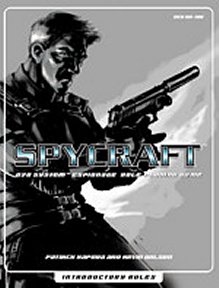
This is an excellent and playable introduction to what promised to be a great game, and which is still worth considering as an introduction for new players even now the full rules are available.
Crammed into the 32 pages is an overview of how the game works. It helps if you are already familiar with the d20 game mechanic, as - in compliance with the Open Gaming Licence - certain parts of character creation are given as reference to the D&D Players Handbook from Wizards of the Coast; and little is explained of how the core mechanic actually works.
In standard d20 style, characters may belong to one of an array of "classes" that determine their starting skills and other attributes. Naturally, being a contemporary game, all characters are human beings - but here the authors have come up with a neat idea to introduce further background and variation: as well as having a class, your character comes from a "department" which gives you further options and resources. This "department" represents the part of whatever (unspecified) intelligence agency you worked for before beginning play, and is more about mindset and approach - were you a suave and manipulative diplomat from the Power Brokerage, a geek from Computer Espionage or, well, whatever it is that lurks in the Basement with all the other misfits?
The classes available are the Pointman, the Wheelman, the Snoop, the Fixer, the Faceman and the Soldier. Some are obvious, but the Pointman is a kind of generalist who can turn his hand to most things; a Snoop is the computer specialist and the Faceman is an intelligence gatherer and the one who can blend in with any group, the fellow you send in when talking rather than shooting is the best option. One of the good things about this work is that you are provided with all the information you need to create a 1st-level character in ANY class, thus a group could give the system a work-out before deciding whether to buy the full game... or a newcomer to a group can begin playing straight away without having to get a copy of the core rules straight away.
Once you have rolled dice for your Abilities (the standard six of Strength, Dexterity, Constitution, Intelligence, Wisdom and Charisma), picked your skills and Feats and worked out how many Wound and Vitality points you have, there is a small selection of weapons and other equipment to choose from. Here there is another ingenious idea, each item may be purchased by spending "Budget Points" or "Gadget Points" for those really clever little items that every secret agent worth his salt has up his sleeve. This represents your agent attempting to requisition the things he needs from his employers - and the mechanism allows for both purchases of your own personal equipment at character creation and for an extra round of "gearing up" that normally takes place after you have received your mission brief and before you go into action.
The range of items is, as you'd expect from an introductory short version, quite limited; but at least you can shoot and protect yourself from being shot. What more could agent ask? There is an interesting approach to armour - rather than merely increasing your Defence, some types give you greater protection from damage rather than making it harder to hit you in the first place. Some people would argue that that's what the arbitrary increases to your Defence reflects, but I think this is more realistic. A bulky and heavy item like a bombsuit in fact makes it easier to hit you, and you don't run as fast as normal when wearing it, but boy, it soaks up the damage, especially if you are caught in an explosion - and that is precisely what the real thing is supposed to do!
Another innovation is the introduction of Action Dice, first seen in AEG's 7th Sea RPG. These are additional dice - d4s at first level - which you can add to your standard d20 roll on those occasions when you really, really do not want to fail. You gain Action Dice by having bright ideas or displaying good role-playing, being awarded them by the GM. This has a hidden side to it - the GM only gains Action Dice for his NPCs by awarding them to the players!
There's a lot crammed into 32 pages, especially considering that it includes a dramatic front cover, a full page of the Open Gaming Licence legalese that's required, a full-page advert for the full game and even a character sheet - which is lacking anywhere to put your Feats and caused grumbles from my group's Soldier, "I have 2 weapons and there?s only space to write the details of one here!"
What this booklet lacks is any idea of opposition. If you want to have a game, the GM - called a "Game Control" - is going to have to make it all up, or get a copy of the full rules. There's some explanation of AEG?s intended setting of Shadowforce Archer, a global privately funded organisation called the Archer Foundation that employs characters to look into whatever is going on - psionics included; and that the mainstream Spycraft game will concentrate on cinematic spies in the James Bond mode.
Finally, I'd like to highlight the approach AEG took in marketing this game. There was a buzz for a good six months, with information flowing freely via the website and a mailing list as it became available. In spy parlance, they decided that we, the fans, had a "need to know." They spared no effort to build up a community feeling amongst those interested in the game, which ensured that it hit the ground running. Something other companies could learn from...
Return to Spycraft Lite page.

